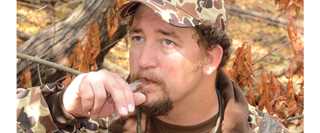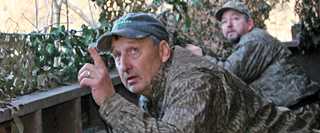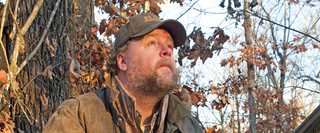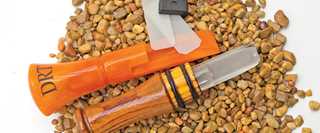Calling Pointers from the Pros
Several of the world’s best callers share their secrets for tolling ducks
Several of the world’s best callers share their secrets for tolling ducks
By Gary Koehler
Who among us hasn't been awestruck by watching a veteran duck caller work a flock of mallards like a maestro handling an orchestra? Even if we come up short in our own calling, we all strive for perfection.
Indeed, few things in duck hunting are more satisfying than luring a flock of greenheads into the decoys via the deft use of a duck call. To improve our own proficiency, many of us seek help from competition callers and other experts through instructional videos and in some cases even hands-on tutorials.
The following sage advice from four duck calling virtuosos is sure to help you entice more ducks into close shooting range this fall.
Kelly Haydel grew up gunning southern Louisiana marshes. His backyard is the extreme southern end of the Mississippi Flyway, a region that typically winters millions of migrating waterfowl. As the youngest son of the late Eli Haydel, an icon of the call-making industry, Kelly was well schooled in the art of calling and learned his lessons nicely.
"First and foremost, I would suggest getting a call that you are comfortable with at your level of expertise," Haydel says. "For beginners, I recommend a double-reed call, which is more user-friendly than a single-reed. The double-reed is easier to control. Start out by learning what the call can do and become familiar with it."

According to Haydel, beginning callers should learn the basics before they move on to more complex calling techniques. "Watching duck hunting TV shows and videos can be confusing for new hunters," he explains. "They see waterfowlers calling in big flocks of ducks, and that can be intimidating. Beginners should relax. You don't have to be perfect when calling ducks. Even live ducks make lsquo;mistakes' when they call."
Haydel says that everything revolves around making a good, raspy quack. "If you can do a good single quack, then you can learn to duplicate quacks over and over for the greeting call. If you can do five quacks in a series, you can sound like a duck. When birds are at moderate to close range, I give them five quacks, and most of the time that's all I need. The only exception is on windy days or when birds are at a long distance. Then I hit them harder," he says.
Mastering the basics is often enough to convince waterfowl to fly within gunning range, while overcalling can be counterproductive. Depending on the situation, sometimes it's better to put on the brakes and hold off as opposed to being extremely aggressive with a call. "The old adage lsquo;Less is more' is true in many situations," Haydel says. "There's a time to be aggressive, like when you are in an area where there's a lot of hunting pressure. But when you use a constant barrage of hail calls over and over again, the calling often loses its effect. In fact, if guys around you are hammering on their calls and it's not working, do the opposite: break from the norm by trying to distinguish your calling from everyone else's."
Iowan Barnie Calef, a call maker and three-time world champion duck caller, regularly guns the Missouri River system and its backwaters, an area with big, wide-open skies. Because he is often calling ducks that are a long distance away, Calef is seldom concerned about raucous calling. "Most of the time, you shouldn't worry about calling too loud," he says. "The exceptions are when you are in tight quarters, or when the ducks are real close. When the birds are way off, I hit them hard most of the time, to get their attention."

Calef contends that timing is everything when it comes to duck calling. "Wendell Carlson had a phrase he'd use in his calling classes that has always stuck with me," he explains. "Carlson often said that the key to calling mallards is giving them lsquo;what they want to hear, when they want to hear it.' Knowing what the ducks want to hear is one thing, but knowing when they want to hear it is vital. About the biggest mistake you can make in the field is calling at the wrong time."
For example, one of the most common mistakes that Calef sees hunters make is calling ducks when the birds are upwind or coming in. "I wait instead, and as soon as the ducks go downwind, I hit them with a five- or six-note greeting call, which at that point amounts to a comeback call," he says.
While on his way to becoming one of only a handful of competitive callers to win three world titles, Calef spent countless hours perfecting his routine. He says that duck hunters can likewise benefit from regular practice. "I always tell folks at my clinics to practice during the off-season," he says. "Get that hen mallard's five to six notes down pat. If duck hunters do that, when they get in the blind during the season it's automatic when they pick up their call. They don't have to think about it because they're prepared."
Calef says that in the end, all duck hunters should become confident enough to call with conviction. "If you're not confident, you're not going to call ducks well. I suggest that people learn what their call can do, get down the basic quacks, then go to a park and listen to ducks and imitate the cadence. I'm a big believer in control, confidence, and cadence. All three are very important," he says.
Call maker Rick Dunn typically hunts ducks in Arkansas's fabled flooded timber. Although he's a former world champion duck caller, he favors a commonsense, step-by-step approach when training novice callers. "The way I try to teach people in my shop is to get them to start with one note," Dunn says. "When they get that right, they add another note, and then another, and so on. A duck commonly uses between five and seven notes."

Learning how to vary these notes, or quacks, as you string them together is key. "It's important to adjust the pitch between the first and last notes," Dunn explains. "You don't want the notes to be monotone. Instead, you want to go from high to low. The first note should also be louder and longer than the rest. Then the notes should get progressively shorter and softer as they come down the scale."
Working on the cadence, or rhythm, of your calling should come next. "Once you get that five- to seven-note series down, you can work on cadence, which can go from slow and drawn out to fast and choppy. From there, duck hunters need to learn how to blow their call soft, medium, and loud, because they're probably going to be using all three of those sound levels in different hunting situations," Dunn says.
Beginning callers should avoid making the mistake of puffing out their cheeks when pushing air through their duck call. "The hotter the air you put into the call, the better the sound you are going to get out of that call," Dunn says. "That hot air comes from the diaphragm. And remember that the volume of air you put into the call should be directly proportionate to how far away the ducks are."
Dunn's approach to knowing when to call and when not to is also straightforward. "Reading the birds' wing beats and body language closely should provide clues as to when calling is necessary," he says. "You call ducks to get their attention. If their wings are cupped and they are on their way in, let them come. Aggressive calling at that point is counterproductive."
One of the biggest mistakes people make is calling too much, adds Dunn, especially when ducks are coming in to land. Calling at that time allows ducks to pinpoint you, and they won't finish. "Don't call when the ducks can easily spot you, or when they are right over you," he says. "As a general rule of thumb, call only when you see the tail end of the duck. If they start to pull away, and you think you are going to lose them, you have a short window to call them back. Then you have to call, because you really have nothing to lose."
World champion caller Jim Ronquest has pursued waterfowl from his home in Arkansas all the way to Canada, with many stops in between. Through it all he has learned that the same calling technique may render different results from one day to the next.
"A mallard duck is a mallard duck, no matter where it may be, so my calling doesn't change a whole lot unless the ducks tell me to do something else," Ronquest says. "One day they might want a raspier sound, another day they may respond better to a more aggressive sound, and the next day they may work to a softer sound. With late-season ducks in particular, you work to get a good reaction and then let them make the next move."

Ronquest, who was a student of the late Butch Richenback, counsels both competition duck callers and duck hunters. In doing so, he shares the lessons he learned from his mentor whenever possible. "I learned a lot from Butch, and one of those things was just how important each of the individual components of calling is," Ronquest says. "Butch stressed picking one thing and learning to do it well. When you get that one thing down, you move on. It all starts with mastering individual notes. Learn to execute the basics properly."
Some newcomers try to run before they learn to walk, a phenomenon not lost on Ronquest. "What I've been seeing more and more is that guys go online and try to duplicate calling routines," Ronquest says. "That's not the way to do it. They are not learning the fundamentals of duck calling."
Ronquest illustrates this point with a recent episode that occurred in his call-making shop. "I had a young man come in the other day," he says. "The guy blew his call for me, and then I asked him to do some quacks. Believe it or not, he couldn't do it. He went through his whole routine again to get to the part I had asked to hear. He didn't know how to separate the individual parts of his routine."
All duck calling is made up of individual notes, Ronquest adds. "The way you get better is to get those individual sounds down, and start building rhythm and natural cadences off those individual sounds," he says. "Then you learn inflection and how to apply all those sounds."
In Tune: A duck call's sound can be altered by moving the reeds in or out. Lengthening the reeds, or pulling them out, will make the call blow louder and will produce a deeper sound. Shortening the reeds will make the call blow softer and will raise the tone to a higher pitch. Novices are cautioned to be extremely careful when manipulating duck call reeds.

Choosing the Right Duck Call: Today duck calls are available in a variety of materials, colors, and styles. This dizzying array of calls is enough to confound even veteran waterfowlers. Choosing a new call can become even more confusing when you consider the fact that no one call can do it all. "People tend to search for the magic flute, a call that will essentially blow itself," says call maker Barnie Calef. "Those are not out there. If you are serious about duck hunting, test out a bunch of calls before you buy one." The key, he adds, is to check out calls that match your style of hunting. "If you hunt open water, for example, you should look for a loud, high-pitched call that will carry long distances. In flooded timber and on other small bodies of water, however, you'll typically want a call with softer volume and pitch," Calef says.

Duck Call Maintenance: Once you've found a duck call that you like, help keep it in proper working order with routine cleaning and care. Residue from coffee, soft drinks, and food can build up in a call's inner workings, particularly in the reeds. Buildup of any kind can alter the call's sound, or make the reeds stick and lock up.

Cleaning acrylic and polycarbonate calls can be as simple as running tap water through the call. To be more thorough, soak the call in a bowl containing a combination of mild dish soap and water. Rinse well, and allow the call to air dry. As an added measure, run a dollar bill or a piece of unwaxed dental floss between and under the reeds.
Double-check the condition of the reeds: Replace cracked reeds with new ones from the same manufacturer to ensure proper size and fit. Many call makers recommend sending the call back to them for maintenance. If, however, you decide to replace the reeds yourself, be sure to mark the tone channel with an indelible pen so you know where the reed was situated before the call was taken apart. If the reeds are not seated properly, the sounds your call produces may startle you-and not in a good way.
1. Try to emulate live ducks, not duck calling videos.
2. Do not overcall if ducks are approaching.
3. Tone down the volume if ducks are close.
4. Test a variety of calls before making a purchase.
5. When operated properly, acrylic calls perform consistently in all weather conditions.
6. Taping your practice sessions will enable you to listen to your presentation and detect deficiencies.
7. Your buddy's call, no matter how great it sounds, may not be a good fit for you.
8. Hail calls are not meant to sound like a single duck, but several ducks at a distance.
9. Do not be afraid to experiment with different calling techniques.
10. Keep in mind that not all ducks will respond to calling.
Ducks Unlimited uses cookies to enhance your browsing experience, optimize site functionality, analyze traffic, and deliver personalized advertising through third parties. By continuing to use this site, you agree to our use of cookies. View Privacy Policy